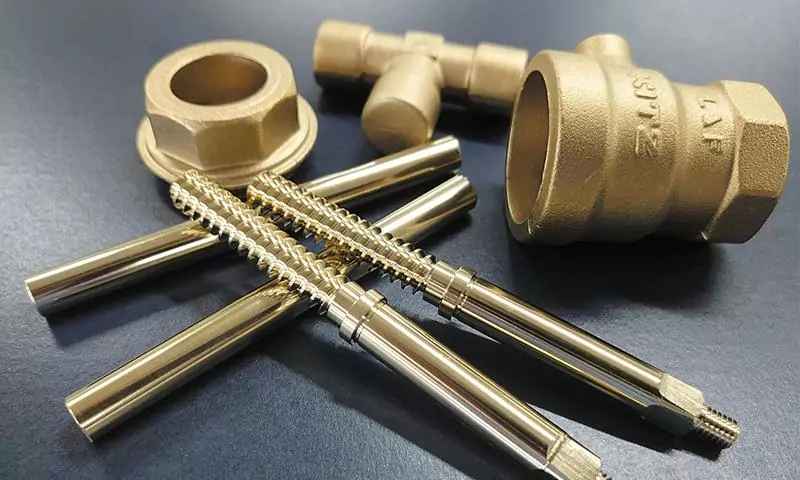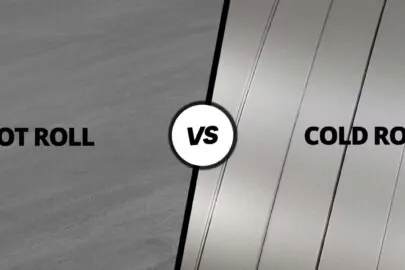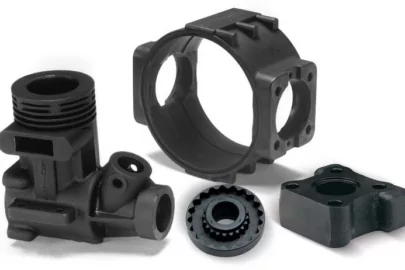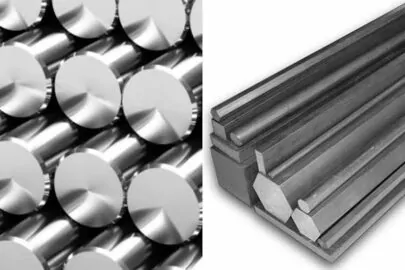Brass material has played a principal role in advancing human civilization. It dates back to the 2nd millennium BC in ancient Mesopotamia, where metalworkers used it for coins, decorations, and copper-zinc alloys. Today, the modern industry relies on brass due to its decorative and functional purposes.
Brass metal is highly versatile, available in different grades, and offers distinct characteristics. Its workability, aesthetic appeal, strength, and corrosion resistance make it widely embraced across industries.
Therefore, you must understand the different types of brass material to determine the right one for your project. Let’s make the work easy for you by giving you a detailed overview of the brass metal. The brass advantages, disadvantages, applications, and comparison we provide here will also help you make the best choice.

What Is Brass?
Brass is a metal alloy comprised of the aggregate of copper and zinc with strains of elements like iron, lead, and others. Generally, the composition of brass includes 66% copper and 34% zinc.
Brass alloys with better copper content material are commonly softer and appear greater gold-like. At the same time, those with low copper and better zinc content are greater rigid and silver-like. Nevertheless, you can alter the percentage of copper and zinc in brass to create shade versions and mechanical, chemical, and electrical properties.
Different Types of Brass Material
You will find various grades and types of brass since the percentage of copper and zinc elements can vary accordingly to achieve specific brass material properties. Similarly, adding other alloying elements, such as aluminum, tin, and manganese, helps to modify the properties of this metal. Here are the common types of brass material:
Alpha Brass
The composition of alpha brasses, which are single-phase alloys, is 35–45% zinc and 55–65% copper. Their crystal structure is face-centered cubic, or FCC. The ductility of alpha brasses contributes to their exceptional cold workability. They are frequently utilized for shaping and drawing applications and have good corrosion resistance.
Small additions of iron, aluminum, and silicon can enhance the mechanical properties of these alloys and harden them through cold working. Alpha brasses have a number of benefits, the main ones being their superior corrosion resistance, great cold workability, and appealing look. Because of their vibrant color and capacity to retain a polished sheen, they are frequently utilized in architectural and decorative applications.
Beta Brasses
Beta brasses with a high zinc content have about 15% copper and 85% zinc. They display a single-phase structure and a BCC crystal structure. Because of their high fluidity and low melting point, these brasses are mostly employed in die-casting. They can be reinforced by heat treatment and have good wear resistance.
But compared to other varieties of brass, they are more prone to stress corrosion cracking. Because they are less expensive than other forms of brass and have superior casting qualities and wear resistance, high-zinc beta brasses are highly prized. They are frequently employed in the manufacturing of die-cast parts, including fasteners, hinges, and locks..
Alpha-beta Brasses
Alpha-beta or duplex brasses contain approximately 55-60% copper and 35-45% zinc. They comprise both the alpha and beta phases. Duplex brasses offer more strength, hardness, and low cold ductility than alpha brass. However, alpha-beta brasses are cheaper than alpha brasses because of their high zinc percentage.
The higher zinc content in these brasses makes them compatible with hot working. Alpha-beta brasses are brighter than alpha brasses and possess the highest strength at 45% zinc content. Typical applications of these brasses include architectural extrusions, radiator valves, hinges, gas appliances, taps, and pipe fittings.
Other common brass materials include:
- Yellow brass
- Red brass
- Leaded brass
Grades of Brass Metal Available
Grades of brass vary according to their elemental composition. Here are the common brass material grades:
Alloy 260 (Cartridge Brass)
Alloy 260 is also called cartridge brass. It consists of precisely 70% copper and 30% zinc. This grade of brass exhibits good formability and is compatible with cold-working. Engineers often employ alloy 260 in making vehicle components, ammunition, and fasteners.
Alloy 280 (Muntz Metal)
This brass alloy primarily contains about 60% copper and 40% zinc. Muntz metal also includes a significant trace of iron. Manufacturers widely use alloy 280 as an economical alternative to copper sheeting on boat hulls to prevent marine organisms such as barnacles from forming on the hulls.
Alloy 360 (Free Machining Brass)
The free-machining brass comprises approximately 60% copper, 35.5% zinc, 3.7% lead, and traces of iron. Alloy 360 is one of the most machinable grades of brass. It is an excellent grade of brass metal suitable for brazing and soldering applications. Typical applications of this brass grade include valves, fittings, fasteners, and hardware components.
Alloy 385 (Architectural Bronze)
Alloy 385, or architectural bronze, comprises 59% copper, 42% zinc, and precisely 3.5% lead. Its constituting elements increase its machinability and formability considerably. Besides, this alloy is a remarkable architectural material for aluminum extrusions due to its easy formability.
Alloy 464 (Naval Brass)
The alloy 464 comprises about 59% copper, 40% zinc, and 1% tin with a small portion of lead. Naval brass exhibits high corrosion resistance and can endure various temperature changes. Moreover, this brass alloy is suitable for multiple applications due to its adaptability for cold and hot forming procedures, welding, bending, and soldering processes. Product designers and machinists commonly use alloy 464 for different fittings used on a boat’s deck.

Brass vs. Bronze vs. Copper: What Are the Differences?
Brass vs. bronze vs. copper are typical red metals with high thermal/electrical conductivity and corrosion resistance. These metals are applicable in different industries with a broad range of uses. Although these metals share some similar properties, here are some of their differences:
| Properties | Brass | Bronze | Copper |
| Element Composition | It is an alloy of copper and zinc. The brass material composition comprises elements like lead, iron, aluminum, manganese, silicon, and more. | Bronze has copper and tin as its primary elements. It may also include nickel, zinc, aluminum, phosphorus, and other elements. | It is a non-ferrous metal in its pure state. |
| Melting Point | Brass melting point is 927°. | Bronze’s melting point is 913°. | Copper has a melting point of 1085°. |
| Weight | Brass has the least weight of the three metals, with a density of approximately 8720 kg/cu.m | Bronze has a moderate density ranging from 7400 to 8900 kg/cu.m | Copper has a density of about 8930 kg/cu.m. Hence, it is heavier than the other two metals. |
| Durability | Brass is less durable than the other two metals due to its low corrosion resistance. It also cracks and splits easily. | Bronze is a sturdy material and doesn’t bend easily. It lasts longer due to its high corrosion resistance. | Copper is a flexible and robust material that allows stretching and bending. However, it doesn’t scratch or crack easily. |
| Corrosion Resistance | Brass is not as corrosion-resistant as bronze and copper. However, some brass alloys, such as naval brass with high manganese content, are usually more corrosion-resistant. | Bronze has the highest resistance to corrosion between the three metals. It develops a protective layer upon exposure to air. However, its exposure to chlorine compromises this property. | Copper undergoes an oxidation process to make its surface resistant to corrosion. |
| Strength | Brass has a yield strength of 95-124 Mpa and tensile strength between 338-469 Mpa. | Bronze has a higher yield strength of about 125-800Mpa and a tensile strength of 350-635Mpa. | Copper has the lowest yield strength of 33.3 Mpa and tensile strength of 210 Mpa. |
| Appearance | Brass has a yellowish-gold color. | Bronze comes in reddish-brown with a dull gold shade. | Copper has a reddish-brown color with a pinkish-orange coloration. |
Advantages and Disadvantages of Brass
Brass offers diverse advantages that make it compatible with different applications. This section discusses the benefits and limitations of brass:
Advantages
- Low Coefficient of Friction: The different types of brass material exhibit a low coefficient of friction. Therefore, they are suitable for sliding-wear applications.
- High Corrosion Resistance: Brass material develops a protective oxide film layer due to exposure to air, preventing further corrosion. As such, brass is suitable for architecture, plumbing, marine equipment, and electronic components.
- Antibacterial: Grades of brass have innate antimicrobial properties due to their copper content. The surface of brasses prevents the growth of bacteria, algae, and germs. As a result, brass is a safe and suitable material for plumbing systems, hospitals, processing equipment, and other applications where hygiene is essential.
- Recyclability: Recyclability is one of the brass material properties that makes it a valuable metal. You can re-melt and reform most brass indefinitely. Furthermore, recycling scrap brass material reduces fabrication costs and the need for additional mineral resources.
- Attractive Physical Properties: Brass is well-suited for making decorative architectural elements, musical instruments, consumer goods, and artistic works because of its bright-gold appearance. Besides, buffed and lacquered brass alloys produce an appealing, durable surface finish for furnishings and equipment.

Disadvantages
- High Cost
- Heavy
- Prone to Tarnishing
- Hazardous Zinc Oxide Fumes
Applications of Brass Material in Manufacturing
Different industries use brass metal material due to its unique properties. Some examples of such industries include the following:
Electronics and Telecommunications
Brass’s electrical conductivity and corrosion resistance make it suitable for electrical components. These components include printed circuit boards (PCBs), plugs, condensers, shielding, switches, etc. Also, brass’s aesthetic appeal makes it an ideal material for making high-end electronic devices.
Marine Equipment
Alloy 464 (naval brass) and other saltwater-resistant brass alloys are widely used to make different components for seagoing vessels. Typical examples of these components include valves, pumps, condensers, propellers, hardware, and fasteners. Moreover, these alloys must resist corrosion, erosion, impact, temperature fluctuations, and electrolytic reactions in marine environments.

Architectural and Decorative Elements
The architectural applications of brass alloys are extensive, including decorative and structural purposes. Manufacturers often use brass alloys to create kick plates, door knobs, furniture trims, and handrails, due to their aesthetic appeal and lasting beauty. On the other hand, the structural uses of brass include roofing, flashing, lanterns, and door hardware.

Musical Instruments
Brass is perfect for making musical instruments, including tubas, bugles, trumpets, French horns, saxophones, trombones, etc., due to its acoustic properties, aesthetic appeal, and castability into accurate bells and tubes. The brass components in musical instruments help generate and amplify rich, resonant musical tones.
Transportation Equipment
Manufacturers use different types of brass grades to make corrosion-resistant, reliable, and attractive parts and components for aircraft, automobiles, and trains. Door handles, fasteners, connectors, trim, radiator parts, and hardware are typical transportation equipment made with brass. Meanwhile, alloy 464 is often applicable to marine propellers, valves, and pumps due to its ability to withstand saltwater.
Factors to Consider When Choosing Brass Materials
Choosing the appropriate types of brass for your project is critical to achieve excellent results. Here are helpful considerations for effective brass material selection:
Prioritize Material’s Machinability
When selecting a brass metal material for your projects, machinability is an important factor to take into account for the best possible outcome. Brass alloy 360, sometimes referred to as free machining brass, is a great option if your task requires accurate machining and near tolerances.
Consider Corrosion Resistance
Corrosion resistance is a need for products that might be exposed to harsh and corrosive conditions. Naval brass, or brass alloy 464, is the ideal choice in this case. Leaded brass also resists corrosion very well in maritime and salinity environments.
Machinability and Strength
These qualities will help you select the best type of brass for your requirements. Brass has a significant lead content, which makes leaded free-machining brass incredibly machinable. Leaded naval brass, on the other hand, is highly prized for its strength and ease of machining.
Examine Aesthetic Requirements
Selecting a grade of brass that has a visually appealing finish would be great. This is particularly true for applications that demand visually appealing designs. For example, because free-cutting brass contains more zinc, it appears more yellow. Thus, it would be ideal for uses where this kind of colour is needed.

Conclusion
Brass is a valuable alloy with numerous uses and specific features. Its diverse properties ensure that designers and product managers can use it for several applications. Therefore, you have to completely apprehend the differences between the distinct varieties of brass material to choose correctly.Whenever you need professional assistance selecting the proper materials for your assignment, Zintilon is right here for you. We provide quality guidance on the appropriate options for custom production operations. Contact us for more information on available brass alloys for your project!
Great, Together



